Learning Geography Trivia with Mastodon Bots
An OpenStreetMap appreciation post
Look, don’t tell anyone but you can always snag my attention with a map. Transit maps, fictional maps, wall maps, historical maps, pocket atlases, game maps, children’s maps of the world, globes,1 aerial photographs for that matter—they’re all fascinating, and so when they go past I tend to stop and take a look. I think it’s a combination of intricacy and novelty, there’s always something new to discover in the details of a good map.
Regardless of the true reason the attractive power works online as well as offline, and there’s nothing like a social media account that posts fresh maps as a by-product of its normal function. I make a game of identifying the location of little inset maps, and I’m going to share two of my favourite Mastodon bots for it.2
The first is @NZWeatherAlerts, currently located on the botsin.space server. This is actually one of mine, and it’s designed to process the feed of weather watches and warnings from the New Zealand MetService and make a thread of info and maps. Here’s an example, for a recent wind watch:

Not to dox myself but I’m fairly familiar with this part of the country, there’s no game here for me. But there are names that I can’t match to places and following (and maintaining) this bot for the better part of the last two years has really helped with that.
Ok, you probably know where this is:
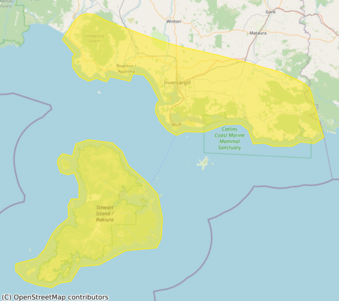
Click here for the answer
This is of course Stewart Island/Rakiura, along with parts of Southland—here is the text of the original post:
Strong Wind Watch - Coastal Southland and Stewart Island
Westerly winds may approach severe gale in exposed places. Chance of upgrading to a Warning: Moderate.
Apologies for the tiny images in this post btw, but also not really: I’m a huge image-size miser on this whole site, and anyway the idea is to be able to identify the place from the broad shapes of the features rather than the text on the map.
All of the maps on these posts are ultimately from OpenStreetMap, one of the best things on the internet. Visually speaking their default style is just the better system when compared to Google and the other corporate mapping tools: Google Maps is gives a massively simplified view of the world and one that is extremely car-centric3 and full of ads, and while this may have uses for some people it has no appeal for me. I only switch to Google for two things: the search, which admittedly is much better, and also because I don’t know of a good OSM web app with transliterated placenames.
Here are two more that are harder:
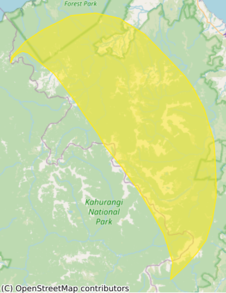
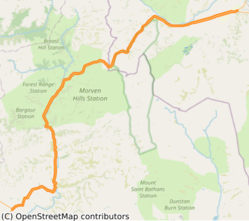
Click here for the answers
The first one is in the Tasman region in the North of the South Island—you might be able to make out the name Kahurangi National Park. Here is the text of the original post:
Heavy Rain Watch - The Tasman Mountains
A period of heavy rain, and amounts may approach warning criteria. Chance of upgrading to a Warning: Minimal.
The second one is Lindis Pass in Otago—here’s the original post for that one:
Road Snowfall Warning - Lindis Pass (SH8)
Snow flurries are likely above 500 metres during Saturday morning and afternoon, but little if any snow is expected to settle on the road.
After a while watching this bot a number of patterns emerge. Certain regions are very common, sometimes literally corresponding to regional council boundaries (I’m not sure if this is because those boundaries are often tied to water catchments, and so have a relationship with climate, or if those regions are sometimes used as a stand-in for a more complex area). The outlines also feel like they are hand-drawn, and are clipped to a different mask for the coast depending on the type of warning.
At this point though the bot is repetitive, and I mostly just follow it for actual weather information. But there is another with much more variety:
@aircraft_alert on airwaves.social posts aircraft “squawking” the 7500 and 7700 emergency transponder codes anywhere in the world (there is also a version that includes the 7600 code, for radio failure, but these are apparently so common they clog your feed up). “Anywhere in the world” isn’t quite true—the planes need to be in range of the receivers used by the particular flight tracking service this bot is attached to, which is biased heavily to the urban US and Europe, but it’s still a lot of interesting places.
Curiously all the maps for this bot are at OSM zoom level 10 which tends to work out in the images to showing about the size of a large metro area at a time. This is not a level that I’ve exactly combed the world at and it can be hard to pick out landmarks. Let’s give it a go:
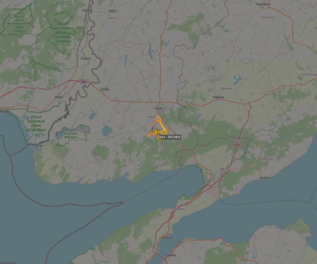
This is a relatively easy one, as they go. Sometimes you can get a clue from the flight number but in this case you absolutely cannot; I assume in this case it’s a millitary aircraft. If mirrored West-to-East—and zoomed out a bunch—it could plausibly be southern Thailand.4
But instead the answer is…
…that the aircraft in this post is over Western Turkey! The coastline here is fairly distinctive: the border to the West is with Greece, and the peninsular to the South is Gallipoli.
Here are two more that are slightly harder:
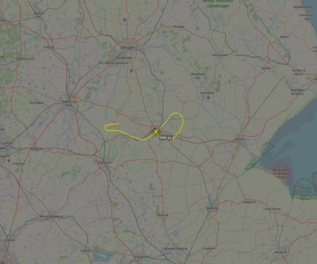

I don’t know what the cause of any of these emergency broadcasts were, nor their consequence.5 I’m assuming this means it was nothing serious and the pilot just leaned on the wrong button, but who knows?
The inlet on the west of the first map has a distinctive rectangular shape which often makes appearances in the images produced by this bot; I’m not sure what that says about the state of the industry in that country. Meanwhile the arrangement of territorial waters in the second map fascinates me.
These locations are…
In the first post we’re looking at a region of England that I believe is called the “East Midlands”—the location of the plane is approximately here.
In the second, we’re in Indonesian waters East of Singapore and Peninsular Malaysia. The defined area of ocean seemingly without any land actually emanates from a tiny island called Pedra Branca belonging to Singapore. The island is also right on the edge of its maritime border, being next to some rocks controlled by Malaysia.
Did you get those? Have three more:

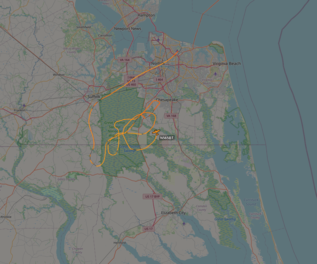
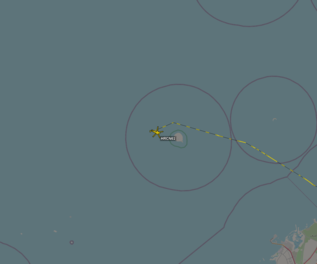
What’s that city in the middle of nowhere? Do you recognise that coast? Where are those islands? Click here for the last set of answers.
- The first aircraft might actually still be on the ground at Billings Logan International Airport in Billings, Montana in the US.
- The second is also in the US, having travelled not very far in a straight line from Norfolk Virginia.
- The final aircraft isn’t in the US but is almost certainly operated by them, in this case in the Persian Gulf in the waters of the UAE.
Did you learn something? I did, so I think I’ll keep playing. What’s the score? Don’t worry about it! It’s not that kind of game.
None of this would have been possible without OpenStreetMap. In the early days Google Maps did make it easy to use their service in this kind of way but they have long since retreated from that position. OSM, both in the form of the underlying data and in the map tiles they make available, remains as a crucial tentpole of this kind of open data, and we should all treasure it more than we do.
It is also a little ironic to be talking about Mastodon bots like this with botsin.space itself, home to one of these accounts and likely the majority of others in the whole network, about to close after seven wonderful years. If you want to follow a bot account like these—or even make your own—then by all means still go for it! In this case the second account isn’t actually on that server, and as for the first (being one of mine) I’ll make sure to find it a new home in time and update the links in this post. Happy mapping!
I could see myself collecting globes, and it scares me. No globes in this house I think.↩︎
“Bots” get a bad rap these days, with paid trolls being given that moniker along with LLM sludge. In this case I’m solidly talking about hand-crafted (and informative!) automated accounts.↩︎
Except in Japan, though I can’t find a proper source for that. Regardless, just check what say Tokyo looks like compared with London, the difference is striking.↩︎
Well ok, if you squint.↩︎
Web searching isn’t coming up with anything, but it’s 2024 so that means nothing.↩︎